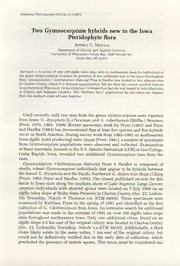
Two Gymnocarpium Hybrids New to the Iowa Pteridophyte Flora PDF
Preview Two Gymnocarpium Hybrids New to the Iowa Pteridophyte Flora
Two Gymnocarpium new hybrids Iowa the to Pteridophyte flora NeKOLA EY C. and Applied Sciences, itural — Green 2420 in Bay, Nicolet Dr., WI Bay, 52311 1 presence of two additional taxa in the Iowa Pteridophyte 3 Gymnocarpium flora. Xbrittonianum (Sarvela) Pryer & Haufler was located two adjacent at sites in Clayton County, where disjunct approximately 300 km from it is the nearest reported stations Gymnocarpium Xintermedium was Sarvela located individual at sites I- Until recently, only two taxa from the genus Gymnocarpium were reported Newman from Newman Iowa: and G. dryopteris robertianum (L.) G. (Hoffm.) (Peck, 1976, 1983, 1989). Recent taxonomic work by Pryer and (1993) Pryer and Haufler (1993) has demonstrated and that at least five species five hybrids occur in North America. During survey work from 1985-1991 on northeastern Iowa algific (cold producing) talus slopes number specimens (Frest, 1981), a of Gymnocarpium from populations were observed and Examination collected. housed of these materials, in the Drexler Herbarium (COE) Coe R.V. College, at Cedar Rapids, Iowa, revealed two Gymnocarpium additional from taxa the Gymnocarpium Xbrittonianum (Sarvela) Pryer & Haufler composed of is Gymnocarpium sterile, robust individuals that appear to be hybrids between the boreal G. dryopteris and the Pacific Northwest G. disjunctum (Rupr.) Ching (Pryer, 1993; Pryer and Haufler, 1993). The closest published records for this taxon to Iowa exist along the southern shore of Lake Superior. Large Gymno- carpium individuals with aborted spores were located on 1990 on an 7 July algific talus slope at Bixby State Preserve in Clayton County Lodom- (Sec. 23, Township, Nekola Thomson [COE These specimens were illo &- s.n. 8499]). examined by Kathleen Pryer in the spring of 1991 and identified as the first An collection of G. xbrittonianum from Iowa. extensive search additional for was made summer populations in the of 1991 on over 100 algific talus slope sites throughout northeastern Iowa. Only one additional clone, found on an km algific slope 0.5 east of the original colony, was located in Clayton County Lodomillo Township, Nekola (Sec. s.n.[COE 23, 9415]). Additionally, a third km clone same likely exists in the valley, east of the original colony, but 1 could not be due which definitively verified to the early date of collection, precluded the presence of mature spores. This taxon must be considered one AMERICAN FERN VOLUME NUMBER 10 JOURNAL: 87 (1997) 1 Iowa of the rarest of ferns, as restricted to two or three small colonies it is km along one a section of a single stream valley. Gymnocarpium x intermedium Sarvela the hybrid between is sterile G. and dryopteris G. jessoense (Koidz.) Koidz. ssp. parvulum Sarvela (Pryer, 1993; and Pryer Haufler, 1993). Whereas G. xintermedium has been reported from Alaska to Northern Quebec, is most abundant along the northern and west- it ern shores Lake Although of Superior. this taxon has been reported from Fill- more County, in southeastern Minnesota Pryer, personal communication), [K. no previously published Two reports of this taxon existed from Iowa. unusual Gymnocarpium populations with aborted spores were summer collected in the 1990 from of algific talus slope habitats in Clayton County Boardman (Sec. 26, Township, Nekola Thomas &- [COE and Dubuque County s.n. 9051]) 4 (Sees. & Taylor Township, Nekola [COE 5, s.n. 8385]). These were by identified K. Pryer in the spring of 1991 as G. xintermedium. Of Dubuque County these, the population was by far the largest, with this taxon being dominant on an open, mossy, cold northwest-facing, algific talus slope. Extensive searches in the summer on of 1991 other slope uncovered no algific sites additional popula- Subsequent tions. examination Gymnocarpium of specimens ft-om other major Iowa herbaria in 1995 by K. Pryer comm.) uncovered (pers. an additional his- torical (1896) collection of taxon from Winneshiek this County [Goddard s.n. [lA, ISC]). Although taxon this typically occurs with both parent species western in its Great Lakes populations, neither G. dryopteris nor G. jessoense parvulum ssp. was located at either of the extant xintermedium G. Discovery sites. of G. jessoense parvulum would var. be important, known as currently not it is as an member extant Iowa of the Kathleen flora. Pryer comm.) (pers. noted the existence two of herbarium specimens of G. jessoense parvulum var. collected m Iowa, portions of a 1882 July collection from Winneshiek County [Holway s.n. [GH]) and a September 1958 collection from Allamakee County {Hartley 6254 [lA]). Unfortunately, the Allamake County specimen could not be located during study and this recent searches for this taxon at the have been un- site successful. my ing 1990 Gymnocarpium coUec- who James Peck 3 not only provided upport of midwestern pteridology. Literature Cited 1981. Final report. Project SE-1-2 (Iowa Pleistocene Iowa Com- snail). Conservation Des Momes. , The pteridophyte flora of Iowa. Proc. Iowa Acad. 83:143-160. Sci. 1983. Additic pteridophyte flora of lowa-II. "" Proc. Iowa Acad. 9028-31 .non A^^- Sci. ^^' • KM Pteridophyte r' *° flora of lowa-III. Iowa Acad. Qof Sci. 96:54-56. " M. J. t-RYER, K. Gymnocarpium . 11993. Newman. Pp. 258-262 in Flora of North America Editorial TWO NEKOLA: GYMNOCARPIUM HYBRIDS NEW TO IOWA Committee, eds. Flora of North America north of Mexico, volume Oxford Uni\ 2.
